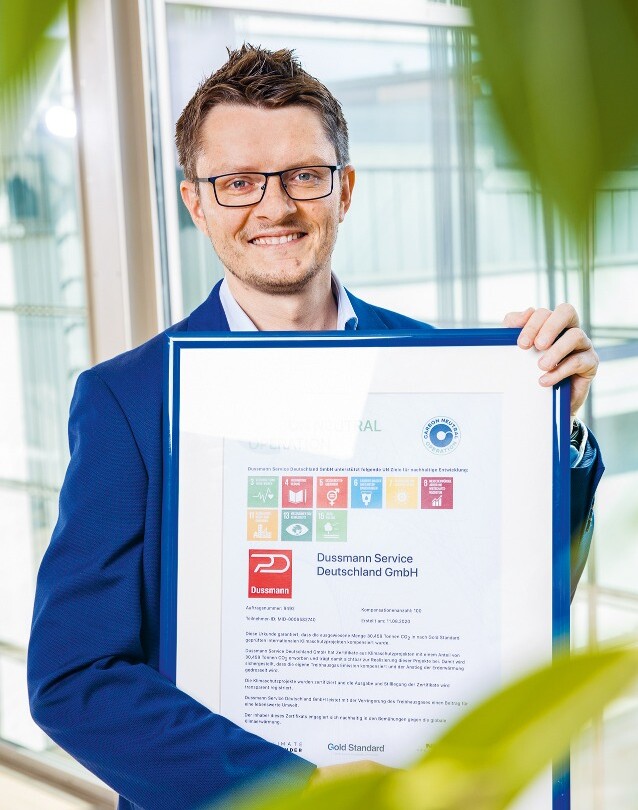
Measuring CO2 in building cleaning: a wealth of advantages for the customer
Sustainable building cleaning: lowering CO2 emissions through transparency
Germany is aiming for climate neutrality by 2045 – an ambitious goal, and one in which the property sector also plays an important role. Reducing carbon emissions is one way the real estate industry can help take action for the climate.
All this means Dussmann Facility Management has good reason to develop measures to reduce the carbon emissions generated during our activities. With measurable success, as initial examples show.
We care for more” is our brand promise, and one of the ways we show our caring is by reducing CO2.
Transparency is key
The first thing that is needed in order to develop suitable measures to reduce carbon emissions is transparency. “That’s why our first step was to take a close look at ourselves and scrutinize every work step involved in our services,” says Sascha Hartmann, Head of Building Cleaning at Dussmann Facility Management in Germany, where he is also responsible for optimizing sustainability performance in building cleaning. At the same time, his experts also analyzed supply chains, particularly in the areas of work clothing, materials, tools and equipment, and cleaning agents. It was a lot of work, but it paid off, because now we have far-reaching transparency in terms of performing services, and the team knows exactly where to dial in to lower carbon emissions.
To be able to look to an understandable overall value for guidance in spite of the wealth of individual facts and figures available, Dussmann Facility Management has begun capturing values for the carbon footprint per hour worked in its building cleaning activities and making this information available for a given property. The figure for cleaning of office properties – including internal management and back office – currently stands at 1.34 kg CO2 per hour worked for variable factors that can be influenced. This value was validated by an independent institute in 2022 based on the Greenhouse Gas Protocol standard.
Three areas with significant potential for reduction
To continue to shrink carbon footprints in building cleaning, the teams working in this field at Dussmann Facility Management take a three-pronged approach:
In the supply chain, Dussmann Facility Management specifically sources products that are produced sustainably and with lower carbon emissions in production and operation. These include ecofriendly cleaning agents, energy-efficient cleaning equipment and tools, electric vehicles, and sustainably produced work clothing for employees (Green Button certification). Dussmann contracts specifically with suppliers that can show above-average carbon performance for their product category and are willing to work on optimizing their CO2 emissions themselves.
As far as the specific service provision is concerned, Dussmann Facility Management trains cleaning staff and others on ways to conserve water, cleaning agents, and energy to preserve precious resources and on sorting waste and recyclables carefully. Intelligent use of human and machine resources and digital and paperless order management also significantly reduce CO2 emissions.
Further CO2 reductions can be achieved in cooperation with the customer, including things like individual arrangements for the times and frequency at which offices are to be cleaned and what the property’s electricity contract is and thus what terms apply to the power used to perform our services. Dussmann Facility Management also offers special packages for companies with very stringent sustainability requirements.
Many advantages for the customer
Dussmann Facility Management has significantly reduced its environmental impact in the area of building cleaning in Germany in the past year by taking a number of measures. How? By using only sustainable vacuum cleaners, switching to ecofriendly garbage bags throughout Germany, and digitalizing paper processes. In 2021, Dussmann also began ramping up its use of ecofriendly mops, efficient cleaning robots, durable cleaning carts, and forward-looking floor cleaning systems, all of which have positive effects on carbon emissions as well.
This yields several concrete benefits for customers. First, they get solid key indicators for their own sustainability reporting and for determining complex Scope 3 emissions. This information allows customers to assess service providers’ performance even better and set out more concrete sustainability targets and measures for themselves. After all, the more precisely carbon emissions can be associated with individual services, the easier it is to find other possible approaches to optimize the carbon footprint together.
Second, these measures reduce carbon emissions, thereby helping to make properties more carbon-friendly. And there are plenty of further advances in the works. Dussmann Facility Management has set ambitious sustainability goals for itself for the future, and these will benefit customers and the environment first and foremost. “‘We care for more’ is our brand promise, and one of the ways we show our caring is by reducing CO2,” Hartmann says. He and his team are already working on further new ideas for reducing carbon emissions.

Customer example: smaller carbon footprint for cleaning 50,000 square meters of office space
Dussmann began cleaning an office space occupying about 50,000 square meters on behalf of a German security technology company in 2022. Dussmann calculated the carbon footprint per hour of cleaning performed for this space. After various optimizations involving the use of products, such as changing the supplier of cleaning agents, and in performing the cleaning services themselves, including using energy-efficient cleaning equipment, carbon emissions were lowered by more than 40 percent per hour worked within one year. This works out to a savings of more than 8 tons of CO2 per year.
1 Working value/current status, average, applies only to maintenance cleaning in office and administrative areas; further research and development is ongoing.
2 Only variable factors that can be influenced directly are considered. The following go into the calculation in detail: machine use in kWh, consumption of water and cleaning agents in liters, the process of preparing the textiles in kWh and liters, person-kilometers for travel to and from the site, and property management.
